小升初英语复习之时态(共30张PPT)知识讲解
- 格式:pptx
- 大小:1.23 MB
- 文档页数:1
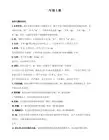
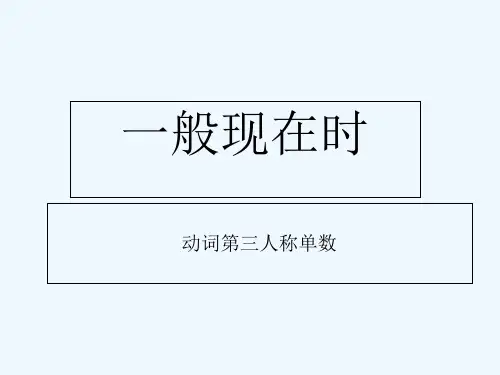
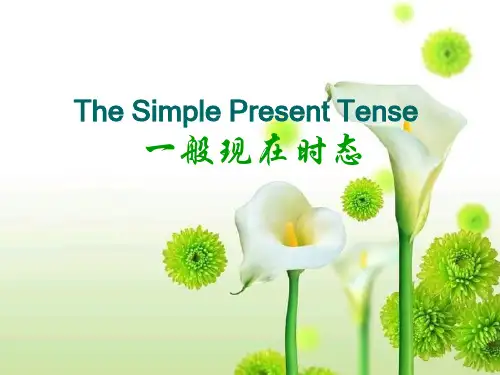
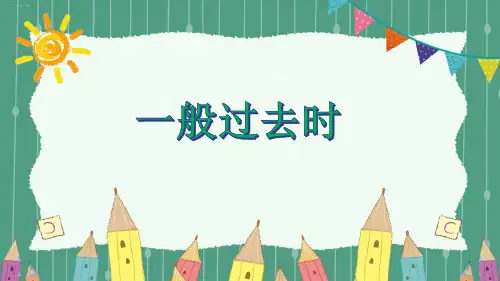

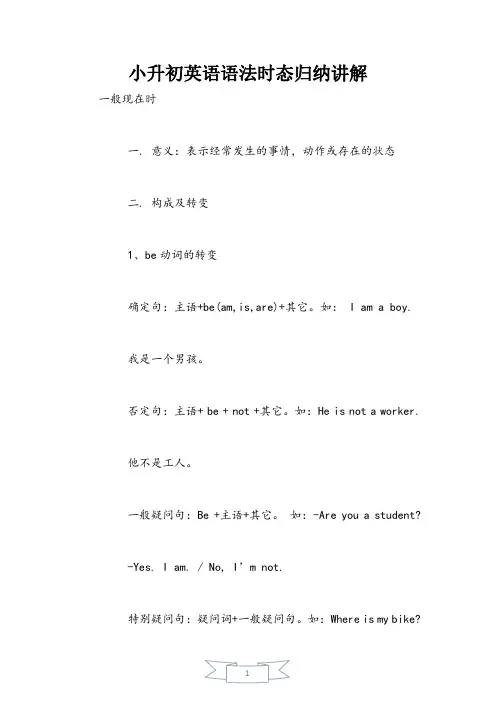
小升初英语语法时态归纳讲解一般现在时一. 意义:表示经常发生的事情,动作或存在的状态二. 构成及转变1、be动词的转变确定句:主语+be(am,is,are)+其它。
如: I am a boy.我是一个男孩。
否定句:主语+ be + not +其它。
如:He is not a worker.他不是工人。
一般疑问句:Be +主语+其它。
如:-Are you a student?-Yes. I am. / No, I’m not.特别疑问句:疑问词+一般疑问句。
如:Where is my bike?2、行为动词的转变当主语为第一,二人称及复数时,助动词为do确定句:主语+动词原形(+其它)。
如: We often play basketball after school.否定句:主语+ don’t+动词原形(+其它)。
如:we don’t play basketball after school.一般疑问句:Do +主语+动词原形+其它?如: Do you often play basketball after school l? Yes, we do. / No, we don’t.特别疑问句:疑问词+以do开头的一般疑问句?如: What do you often do after school ?当主语为第三人称单数时 ,助动词为does确定句:主语+动词三单式(+其它)。
如: He swims well.否定句:主语+ doesn’t+动词原形(+其它)。
如:He doesn’t swim well..一般疑问句:Does +主语+动词原形+其它。
如:Does he swim well ?Yes, he does. / No, he doesn’t.特别疑问句:疑问词+以does开头的一般疑问句?如: How does your father go to work?三、第三人称单数的动词转变规章(只有在第三人称为主语的确定句中,动词才用三单式)(1)多数动词径直加s:runs gets likes collets takes plays climbs…….(2)结尾是s, x, sh, ch, o,前为辅音字母,结尾加es :watches teaches goes does washes crosses mixes brushes(3)动词末尾y前为辅音:将y改为i加es:study→studies fly→flies carry→carries cry→cries但在y前假如为元音则径直加s:buys says四、时间标识:always , usually , often , sometimes ,every…现在进行时一、意义――当表示现在正在进行的动作或正在发生的事。

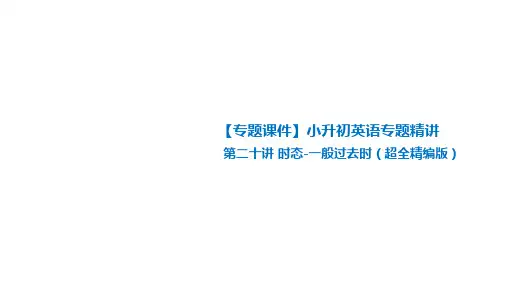
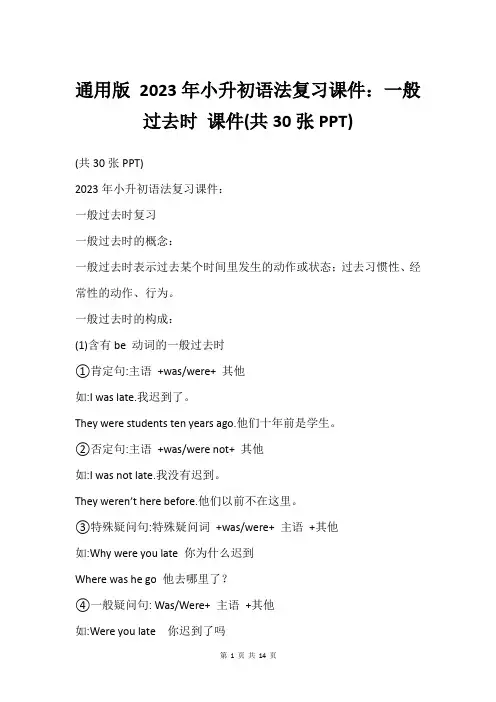
通用版2023年小升初语法复习课件:一般过去时课件(共30张PPT)(共30张PPT)2023年小升初语法复习课件:一般过去时复习一般过去时的概念:一般过去时表示过去某个时间里发生的动作或状态;过去习惯性、经常性的动作、行为。
一般过去时的构成:(1)含有be 动词的一般过去时①肯定句:主语+was/were+ 其他如:I was late.我迟到了。
They were students ten years ago.他们十年前是学生。
②否定句:主语+was/were not+ 其他如:I was not late.我没有迟到。
They weren’t here before.他们以前不在这里。
③特殊疑问句:特殊疑问词+was/were+ 主语+其他如:Why were you late 你为什么迟到Where was he go 他去哪里了?④一般疑问句: Was/Were+ 主语+其他如:Were you late 你迟到了吗Was she quiet before 她以前是文静的吗?(2)谓语动词为实义动词的一般过去时①肯定句:主语+ 动词的过去式(+ 其他)如:I visited France.我参观了法国。
They went to the Great Wall in summer holiday.他们暑假去了长城。
②否定句:主语+did not+ 动词原形(+其他)如:I did not visit France.我没有参观法国。
They didn’t went to the Great Wall in summer holiday.他们暑假没有去长城。
③特殊疑问句:特殊疑问词+did+ 主语+ 动词原形如:Where did you visit 你参观了哪里How did John went to Sanya 约翰怎样去三亚?④一般疑问句: Did+ 主语+动词原形(+其他)如:Did you visit France 你参观法国了吗Did John go to Sanya last year 约翰去年去三亚了吗?(1)表示在过去某时间发生的动作或存在的状态。
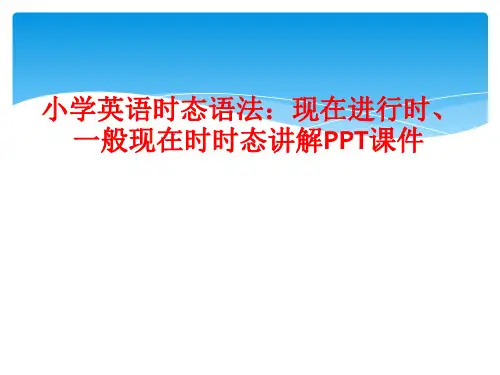
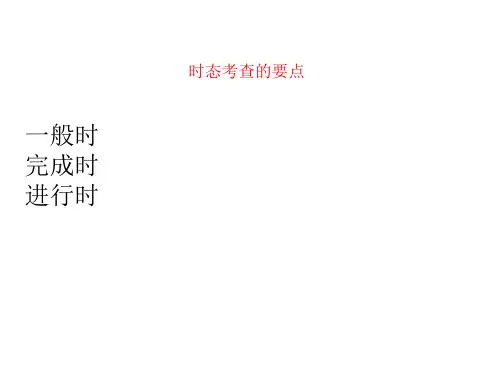
小升初时态专题复习一般过去时态一、知识点讲解:重点、考点:一般过去时态(一)概念1.表示在过去某个时间发生的动作或存在的状态。
2.也表示过去时间里经常或反复发生的动作。
例如:I watched TV last night. 我昨天晚上看电视。
What did you do yesterday? 你昨天做了什么?They went to Beijing last year. 他们去年去了北京。
(二)标志词(一般过去时的常用时间)(三)动词过去式一般过去时句子中谓语动词用相应的过去式形式。
1、规则变化:(动词过去式的变化可速记为“直”、“去”、“改”、“双”四字诀。
)词尾辅音字母,再+ed2、不规则变化:①常见的拼写不变动词(AA型)letlet putput costcost cutcut hithit hurthurt readread②其他不规则(AB型)am/is was arewere dodid gowenthavehad ecame makemade taketook[来源:学. knowknew leaveleft loselost learn learned swimswam runran getgot sitsatsaysaid seesaw sellsold sendsentbuybought thinkthought teachtaught bringbroughteatate drawdrew drinkdrank drivedrovesingsang speakspoke standstood wakewokefallfell feelfelt findfound givegavewinwon willwould shallshould cancouldflyflew hearheard keepkept sleepslept(四)时态与句型1、谓语动词是be动词时,一般过去时的构成形式,详见下表:一般过去时的构成形式: be 动词肯定式疑问式否定式I was... Was I ...? (或Were you ...?) I was not ...He / She / It was... Was he / she / it ...? He / She / It wasn't ...We / You / They were ... Were we / you / they ...? We / You / They weren't ... 即:主语+be(过去式)+其他否定句:主语+be(过去式)+not+其他(wasn’t weren’t)一般疑问句:Be(过去式)+主语+其他(第一人称变为第二人称)特殊疑问句:疑问词+Be(过去式)+主语+其他(第一人称变为第二人称)例如:I was at home yesterday evening.否定句:I was not at home yesterday.一般疑问句:Were you at home yesterday? Yes, I was. / No, I wasn’t.特殊疑问句:Where were you yesterday evening? I was at home.2、谓语动词是实义动词时(句中没有be动词),一般过去时的构成形式,详见下表:一般过去时的构成形式: 实义动词肯定式疑问式否定式I worked ... Did you (或I) work ...? I didn't work ...He /She /It worked ... Did he / she / it work ...? He / She / It didn't work ...We / You / They worked ... Did you / we / they work ...? We / You / They didn't work ... 即:主语+实义动词过去式+其他否定句:主语+didn’t+动词原型+其他一般疑问句:Did +主语+动词原形+其他(第一人称变为第二人称)特殊疑问句:疑问词+ did +主语+动词原形+其他(第一人称变为第二人称)例如:I watched TV last night.否定句:I didn’t watch TV last night.一般疑问句:Did you watch TV la st night? Yes, I did. / No, I didn’t.特殊疑问句:What did you do last night? I cleaned my room.二、课堂练习:I、写出下列单词的过去式形式。